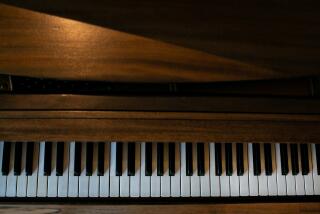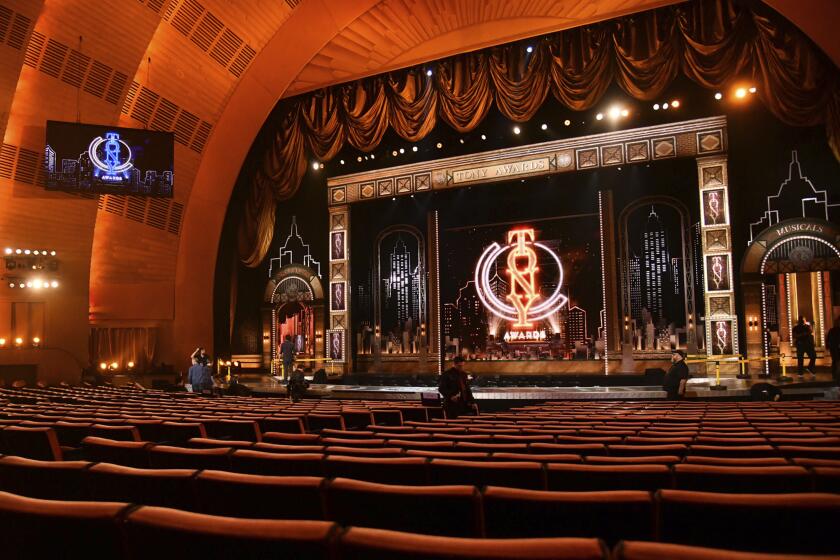Barbosa-Lima’s Music Is Sum of Its Ethnic Parts : Recital: Brazilian guitarist, who plays Sunday at Chapman University in Orange, favors a diverse, multicultural approach.
- Share via
The guitar is one of the original multicultural musical instruments. Born in the melting pot of Mediterranean cultures and nurtured from birth with popular and folk music as well as the formal creations of art musicians, it still plays an important role in many types of performance.
That stylistic diversity also characterizes the art and career of Carlos Barbosa-Lima, the 47-year-old Brazilian guitarist who gives a recital Sunday at Chapman University in Orange.
“If you go back to Sanz--and even before that, to the Spanish Renaissance--you find popular music, songs and dances, a major part of the (guitar) repertory,” Barbosa-Lima notes.
“The guitar is so important in so many cultures, especially now, because it has so strong a voice. It’s a real people’s instrument. . . . I think it facilitates a kind of very diverse, multicultural approach.”
That approach is apparent in Barbosa-Lima’s current projects. He tours with Sharon Isbin, doing Gershwin’s “Rhapsody in Blue” in a version for two guitars alone and another for two guitars with orchestra; he’s writing his second book on polyphonic techniques for the guitar, explaining musical aspects with examples; he is in the middle of recording an album with jazz guitarist Charlie Byrd; he has just published six transcriptions of Dave Brubeck classics, and has finished a similar Copland project.
His Chapman program features music with strong vernacular roots, particularly in the Brazilian samba and choro traditions, from his most recent album, “Music of the Americas.”
“My program is a combination of music of the Americas, and Scarlatti and Debussy,” the guitarist said by phone recently from his New Jersey home. “I’m going to start with a group of Brazilian pieces in the popular style. The first half ends with the Ginastera Sonata. Then comes some Gershwin and Brubeck arrangements, and I end with more popular favorites, including some Jobim. It’s kind of a turnaround program.”
Arrangements are often the bane of guitar programs, but they are a highlight for Barbosa-Lima. This program includes one of his Brubeck transcriptions, “Kathy’s Waltz.”
“Brubeck was very supportive, and said he had never seen anything like it. I like jazz because there is an architectural form behind the music, but it leaves room for improvisation,” Barbosa-Lima says. “I do some improvisations, or variations on the themes, in which I incorporate some of my own ideas.”
Part of the joy of arranging for Barbosa-Lima is in the collaborative nature of the effort. He was equally involved in the creation of one of the true monuments of the 20th-Century guitar repertory, the Sonata that Alberto Ginastera dedicated to Barbosa-Lima in 1976.
“The Ginastera Sonata was a great experience for me,” Barbosa-Lima says, “because I worked so closely with the composer on it. So much arranging was involved. It was really magnificent, a breakthrough experience for me.”
Barbosa-Lima came to the instrument early. He had an uncle who played a little bit, and his father at one point decided to take guitar lessons to play along at home musicales.
“In Latin America, the guitar plays a strong part in every house,” he said. “I watched my father’s lessons and became immediately attracted. I would sit nearby and soak it all up. After nine months, I was doing what my father should have been playing.
“I quickly made progress. I took lessons in music theory, but my study of the guitar itself was not really organized, more like an experiment, until I began with Isaias Savio. I began to cross boundaries early in my life, and so I have no difficulty with it. I like the challenge of different styles.”
Though well-grounded in classical techniques and styles by Savio, Barbosa-Lima never neglected his roots.
“In the early 1960s, I was approached by a Brazilian record company to do some popular Brazilian pieces by Catullo and Nazareth,” he said. “There was very little written down, in very poor charts. So I found old recordings and talked to everyone who had played with them, and got a kind of audio basis for myself.
“That was the first experience of what I’m doing now. I left it for a while, and now I’m back. The merging of styles is always fascinating.”
That should be evident in his Chapman recital, which shares much of the program with the one he played at Pasadena’s Ambassador Auditorium in February. There his Jobim set was memorable.
“I feel close to Jobim, who was very rewarding to work with,” Barbosa-Lima said. “Jobim is a craftsman, absolutely, in how to approach the guitar. We worked together in a very special time. He was in New York for several months, working with me revising harmonies and working out the linear elements.”
Barbosa-Lima teaches at the Manhattan School of Music, and Monday he will also give a master class at Chapman.
Teaching “is a very good experience,” he said. “The level of guitarists has gone way up. I enjoy that side of my life, too. It keeps me in touch, from a different angle, with the more traditional guitar repertory.”
His advice to students generally proves characteristically open-minded.
“Learn to play the guitar, period. Then you can apply it to anything. The point is to make things worth it musically.”
As a pedagogue, Barbosa-Lima does not rush to judgment, remembering the experimental nature of his own early studies. He has no desire to mold young players in his own image, idiosyncratic and changeable as that is.
So when he hears students, Barbosa-Lima listens for the whole spectrum of their playing, and makes musical points before dealing with technique.
“I try to listen, rather than stopping a student immediately,” he said. “I don’t mind pieces I don’t know, which are fun in a way.”
Indeed. Barbosa-Lima paraphrases Duke Ellington’s dictum that what sounds good, is good.
“Whatever style, good music is good music. I wish more and more that the multicultural side of the guitar should be incorporated into study and concerts. In that way, it can never be boring.”
Guitarist Carlos Barbosa-Lima will perform works by Scarlatti, Debussy, Villa-Lobos, Gershwin, Ginastera, Pernambuco, Savio, Santorsola, Lauro, Mignone and Vianna on Sunday at 8 p.m. in the Chapman Auditorium at Chapman University, 333 N. Glassell St., Orange. $12 to $15. (714) 997-6591.
More to Read
The biggest entertainment stories
Get our big stories about Hollywood, film, television, music, arts, culture and more right in your inbox as soon as they publish.
You may occasionally receive promotional content from the Los Angeles Times.










